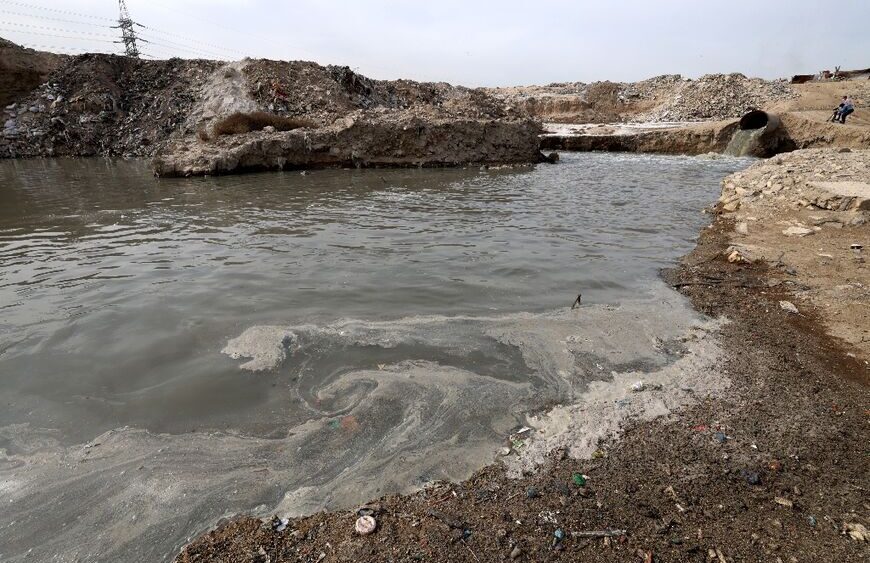Iraq is grappling with severe environmental issues, including water pollution. In this article, Dania Al Khafaji investigates the pervasive problem of Tigris River pollution in Baghdad. While most of the population in the urban areas of Baghdad use bottled drinking water rather than tap water, others living in rural areas are still relying on tanker water, fearing contamination of water bodies with toxic substances and pathogens.
For Millennia the Tigris River has served as one of the most significant historical rivers in the world. Being essential for Iraq’s agricultural drinking water supply and the ecological balance. Despite “booming” federal budgets over the past two decades, successive governments have failed to tackle the critical issue of water pollution, a major cause of many diseases affecting the population. In March 2023, the Iraqi Observatory for Human Rights (IOHR) reported that Baghdad’s water is heavily contaminated, with oil, medical waste, and untreated wastewater being dumped into the Tigris River. An assessment by UNICEF in 2023 revealed that only 30% of Iraq’s population has access to proper sewerage sanitation facilities, and while 83% of households have access to clean drinking water, this figure plummets to just 23% in some rural areas. The situation exacerbates waterborne diseases, especially among vulnerable groups like children, due to the link between contaminated water and poor environmental hygiene. In 2022, the Central Statistical Organization (CSO) reported 259,488 diarrhea cases among children under the age of 5, mainly caused by waterborne pollutants.
Iraq’s polluted rivers threaten daily life and pose serious health risks © FRANCE 24 English (28 Aug 2023)
Industrial wastewater and untreated sewage have become more potent as the river runs south, posing serious risks to both the environment and public health, especially during the dry months, when the Tigris’s levels drop, and the river’s ability to dilute pollutants diminishes, leading to a concentration of harmful substances in the water.
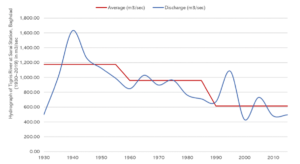
As Iraq’s population grows annually, water pollution continues to worsen. The country’s water treatment infrastructure is deteriorating, while the amount of oil and medical waste being dumped into rivers is rising. In March 2023, Issa Al-Fayyad, the director-general of the technical department at the Ministry of Environment, stated in an interview with the state television, Al-Iraqiya, that the primary cause of water pollution in Iraq is the untreated sewage wastewater being discharged into rivers. He highlighted that the sewage treatment plants in Baghdad are designed for a population of only 3 million, while the city is home to around 9 million people. The visibility of pollution in Baghdad is noticeable when Tigris River levels drop, particularly in densely populated areas. Along Abu Nuwas Street, near the Green Zone, unpleasant odors often waft through the air at night. These smells are due to sewage from the Karrada district being discharged directly into the river. According to a white paper published by a former Minister of Health in May 2019, 5 million cubic meters of sewage water are discharged daily to the rivers, mainly without treatment.
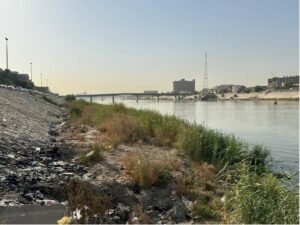
Tigris River, Baghdad
Massive quantities of untreated wastewater from households, factories, and hospitals are released daily directly into the Tigris River, despite the Municipality of Baghdad claiming all the wastewater is treated before discharging to the river. Meanwhile, Iraq’s wastewater treatment plants, which serve just 36% of the population, are operating below capacity. In many urban areas, aging sewage networks are leaking, allowing sewage to seep into the groundwater and rivers, exacerbating the pollution problem.
The Central Statistical Organization (CSO) reported in 2022 that Baghdad, a city with over 9 million residents, is served by 10 wastewater treatment plants with a combined design capacity of 955,000 cubic meters per day. This translates to about 38.73 cubic meters of wastewater treatment per capita per year, significantly below the Middle East average of 51.4 cubic meters and the global average of 49.0 cubic meters per capita per year. One official from the Baghdad Environment Department said in 2023 to the Independent Arabia news outlet that more than 500,000 cubic meters per day are discharged without treatment. According to Yale University’s Environmental Performance Index (EPI), Iraq ranks 73rd out of 180 countries in water resources management. The main factors contributing to the declining water quality in the Tigris River include improper disposal of municipal and industrial waste and the unregulated use of sewage systems.
Microbial and chemical pollutants are the main factors responsible, either exclusively or in combination, for various public health problems. Improper treatment of drinking water often leads to various diseases, including typhoid, amoebiasis, ascariasis, hepatitis, diarrhea, vomiting, and even cancer, and neurological illnesses. According to the Central Statistical Organization, 259,488 children under the age of 5 were affected by diarrhea in 2022 including 34,723 cases in Baghdad alone.
The CSO reported in 2022, that the coliform and E.coli levels have reached 540,000 per 100 mL in samples taken near Kadhimya, north of Baghdad. Coliforms themselves are not usually harmful, but their presence in water indicates possible fecal contamination and the risk of dangerous pathogens like E.coli that can cause gastrointestinal illnesses, infections, and other serious health problems. The WHO or European Union standards often recommend not exceeding 5,000 total coliforms per 100 mL for surface water that is not directly intended for drinking or recreational use but is still part of a managed water body. The river contamination have been exacerbated by climate change, factors such as decrease of water flow due to change in precipitation pattern and the increase in temperature making surface water more susceptible to the pollutant concentration.
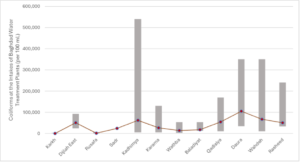
(Data Source: CSO- 2022)
Water quality treatment is done by the Mayoralty of Baghdad at nine monitoring stations along the Tigris River. However, research on the levels of chemical contamination in Iraq’s drinking water, particularly in Baghdad, is surprisingly scarce. Compounding this issue is the lack of precise governmental data on the contamination levels in drinking water sources. A study conducted by researchers from Al-Karkh University of Science in 2021 showed high levels of heavy metals, including lead, cadmium, chromium, copper, cobalt, iron, and nickel—elements that pose a significant threat to human health in some areas of Baghdad. Lead contamination was found in the samples taken from the Tigris River near Al-Sarafiya Bridge and a water well in Al Fadhilia Neighborhood with concentrations 13 times the safe limit. In 2023, the Iraqi Observatory for Human Rights confirmed the severe water contamination issues in Baghdad, noting that untreated sewage, medical waste, and oil are regularly dumped into the Tigris River.
According to one article published by the local news agency ‘Shafaq News” in April 2024, the Diyala River, a tributary of the Tigris south of Baghdad, is heavily polluted and has become a cause for the transmission of diseases. According to the article, the water has turned green with a foul smell. Another element to be addressed in the market of this environmental disaster is the effect that pollution imposed on aquatic biodiversity. Toxic waste has negative effect on fish population an essential to the Iraqi economy and food security. The pollutant is seeping beyond water into the soil risking agriculture output.”
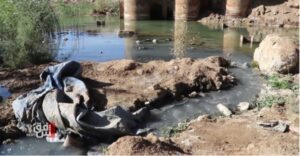
Diyala River (Shafaq News, 2024)
The Iraqi Prime Minister gave the approval of a $768.6 million proect to upgrade Baghdad sewage system in 2023. The project has the capacity of 480,000 square meters and is considered a vital infrastructure that will serve more than 8,000 residents. However, despite progress with the project and many other sewage upgrading issues, Iraq has not established a strict regulation frame for efficient discharge and water treatment. There is no legislative enforcement from the Ministry of Environment and the Ministry of Municipality and no monitoring procedure to ensure the treatment plants meet international water quality standards. Without addressing the law and operation that are currently in place no amount of investment in advanced technology. The Tigris River pollution crisis exposes a stark reality despite existing laws and regulations, weak enforcement has allowed this vital waterway to become a dumping ground for untreated sewage, industrial waste, and hazardous materials, endangering millions of lives. The river, once a source of life, now poses a serious threat to the health and well-being of Iraq’s population. Urgent action is needed to clean up the Tigris—strengthening regulations, investing in modern wastewater treatment, and raising public awareness are crucial steps. Without immediate intervention, Iraq risks losing one of its most precious natural resources, with dire consequences for its people and future.
DANIA AL KHAFAJI
An Environmental Geologist from Iraq. My academic journey in geoscience at the University of Basra ignited my dedication to environmental preservation, where I delved into the study of heavy metal contamination in water. I published multiple scientific research papers in internationally recognized magazines and represented my country in the international competition for geologists. The youngest to get awarded a Chevening Scholarship, I had the chance to study at Cardiff University, UK, where I focused on Geological and Environmental Hazards, and undertook a thesis on Monitoring surface water availability in the face of dough in East Africa.
![Iraq Climate Change Center [IC3+]](https://iraqclimatechange.org/wp-content/uploads/2024/06/logo2.png)
